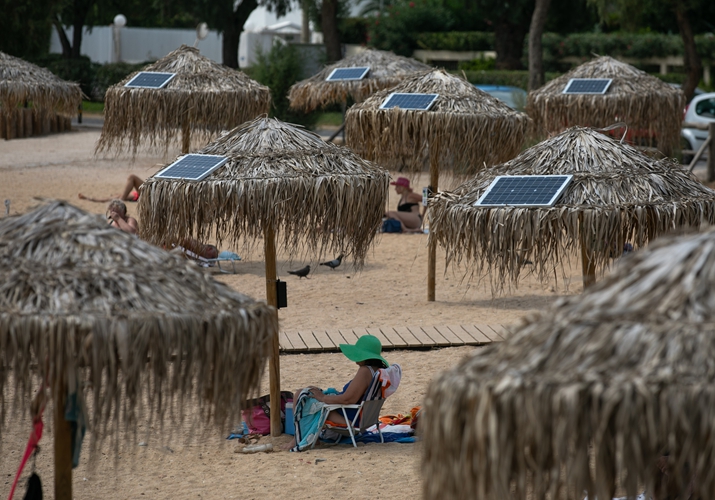Climate Ambitions Can Be Met Only Through Cooperation Among Countries

International commitments and continuity of policies need to be ensured. Developed nations need to update and submit new INDCs to raise their targets for increasing the use of renewable energy and cutting carbon dioxide emissions.
When President Xi Jinping addressed the Climate Ambition Summit on December 12, he updated China’s carbon targets for 2030, which came close on the heels of the September pledge to have carbon dioxide emissions peak before 2030 and achieve carbon neutrality before 2060.
The new goals have been broken down into concrete steps China will take in the next 10 years. Carbon emissions will be cut by over 65 percent per 10,000 yuan ($1,520) of GDP from the 2005 level and non-fossil fuels will account for around 25 percent of the primary energy consumption. The forest stock volume will be upped by 6 billion cubic meters from the 2005 level and wind and solar power generation capacity will be raised to at least 1,200 gigawatts.
“China always honors its commitments,” Xi said at the virtual summit, attended by dozens of leaders of developed and developing countries, as well as international organizations, representatives of non-governmental organizations, and business leaders.
The summit, which was held to make new commitments to tackling climate change and delivering on the Paris Agreement on climate change, was co-convened by the UN, the UK and France, in partnership with Chile and Italy.
Five years on from the signing of the historic deal in Paris, meeting its central goal—limiting global average temperature rise to well below 2 degrees Celsius above pre-industrial levels by the end of the century—looks to be a severe challenge still, considering some major emitters’ inaction on climate change.
Xi has said China will follow three principles to foster international cooperation: embracing multilateralism and taking collective climate action; upholding the principle of common but differentiated responsibilities; and pursuing sustainable and green economic recovery.
China remains resolved to reduce climate threats to sustainable development and human wellbeing and undertake new international responsibilities and obligations.
New targets
Targets, policies and measures have been introduced for reducing greenhouse gas (GHG) emissions by 2020. China is the first developing country to adopt and implement a national climate change program and submit its intended nationally determined contributions (INDCs) to the UN Framework Convention on Climate Change. The 13th Five-Year Plan (2016-20) made it a national priority to promote ecological conservation for the first time.
According to official statistics, by the end of 2019, China’s carbon intensity had decreased by 48.1 percent from 2005, and non-fossil energy accounted for 15.3 percent of primary energy consumption. The 2020 targets for tackling climate change have been met three years ahead of schedule. The progress in forest coverage has been remarkable, contributing to a quarter of the world’s afforested area since 2000.
In addition, China has been the world’s largest new-energy vehicle market for five years, with cumulative sales of almost 4.2 million units through 2019.
The Communist Party of China Central Committee’s proposals for the 14th Five-Year Plan (2021-25) and the long-range objectives through 2035 state explicitly that China will realize economic and social development by promoting the green economy.

Multilateral cooperation
Some politicians have pursued a unilateral policy in global affairs, which has undermined international climate cooperation. The novel coronavirus disease pandemic has also exacerbated people’s pessimistic feelings about the future. China supports multilateral processes and is boosting concerted global efforts.
One partner is the EU, with whom China has long-standing cooperation in addressing climate change. The EU-China Partnership on Climate Change in 2005 set up a stable strategic framework for dialogue and cooperation, affirmed by subsequent statements.
The cooperation extends to a wide range of areas including long-term low-carbon development strategies, carbon emission trading, energy efficiency and investment in climate and clean-energy projects.
Though a developing country itself, China is also offering financial and technological assistance to other developing countries to help them meet the challenge of climate change. The $3-billion China South-South Climate Cooperation Fund helps recipients enhance their climate response capacity. Ten pilot low-carbon demonstration zones are being built across the world while 100 mitigation and adaptation programs have been started.
China is also willing to develop climate and clean-energy cooperation with the upcoming U.S. administration. The U.S. is one of the biggest polluters in the world and has produced more GHG emissions than any other industrialized country. Though the outgoing administration under President Donald Trump pulled out of it, President-elect Joe Biden campaigned on an ambitious climate strategy, saying he will prioritize comprehensive climate and clean-energy plans. Biden has promised to re-enter the Paris Agreement the day he takes office. In the near future one can be cautiously optimistic about China-U.S. re-engagement and cooperation on climate change and energy security.
There is already a foundation for that. During the tenure of Trump’s predecessor Barack Obama, China and the U.S. developed extensive climate dialogues and exchanges and institutionalized coordination and cooperation. A regular ministerial-level dialogue mechanism was established as well as entities like the China-U.S. Climate Change Working Group and the China-U.S. Clean-Energy Research Center.
If the U.S. returns to the Paris Agreement, it will have a wider base of support.
A global issue
Both the global ecological environment and global climate governance need emergency action. The 26th UN Climate Change Conference of the Parties was rescheduled to November 2021 because of the pandemic and there are fears that the Paris Agreement is falling apart.
The legal status of the accord needs to be strengthened. It lacks rules designed to prevent irresponsible actions, like the U.S. withdrawal. All the signatories, especially the major emitters, should be held to their obligations.
International commitments and continuity of policies need to be ensured. Developed nations need to update and submit new INDCs to raise their targets for increasing the use of renewable energy and cutting carbon dioxide emissions. Climate change is a global challenge and it can be resolved only through international cooperation.
The author is an associate research fellow with the China Institute of International Studies.
 Facebook
Facebook
 Twitter
Twitter
 Linkedin
Linkedin
 Google +
Google +










